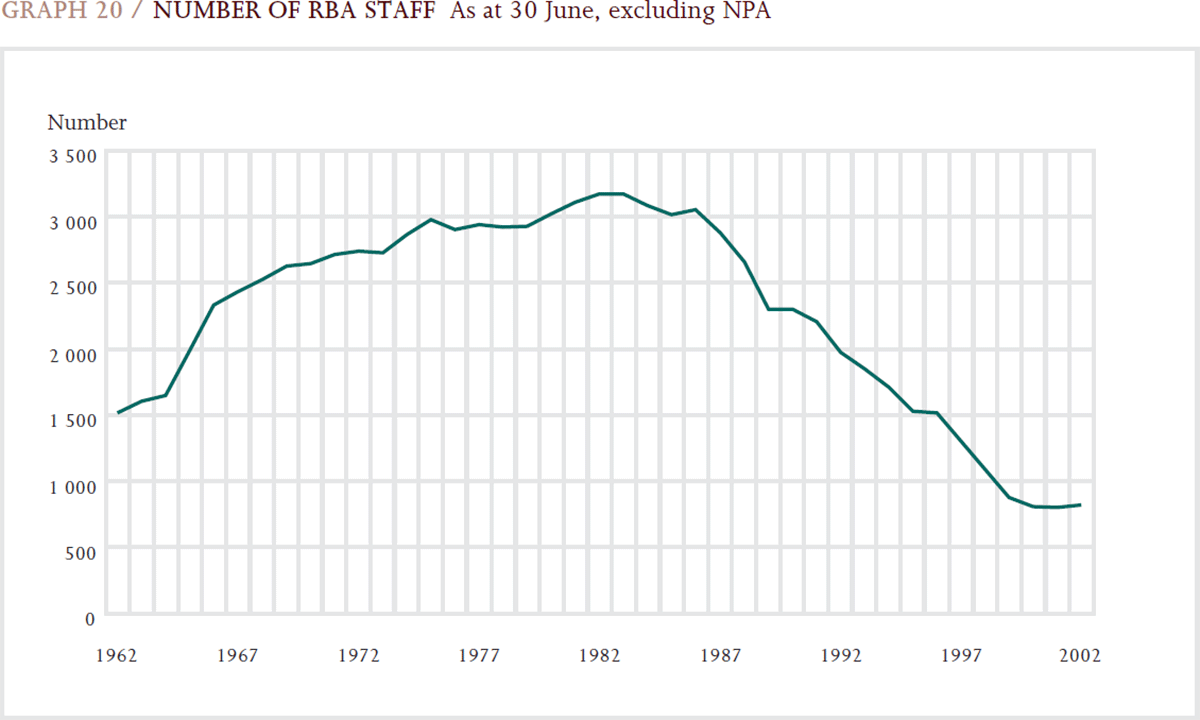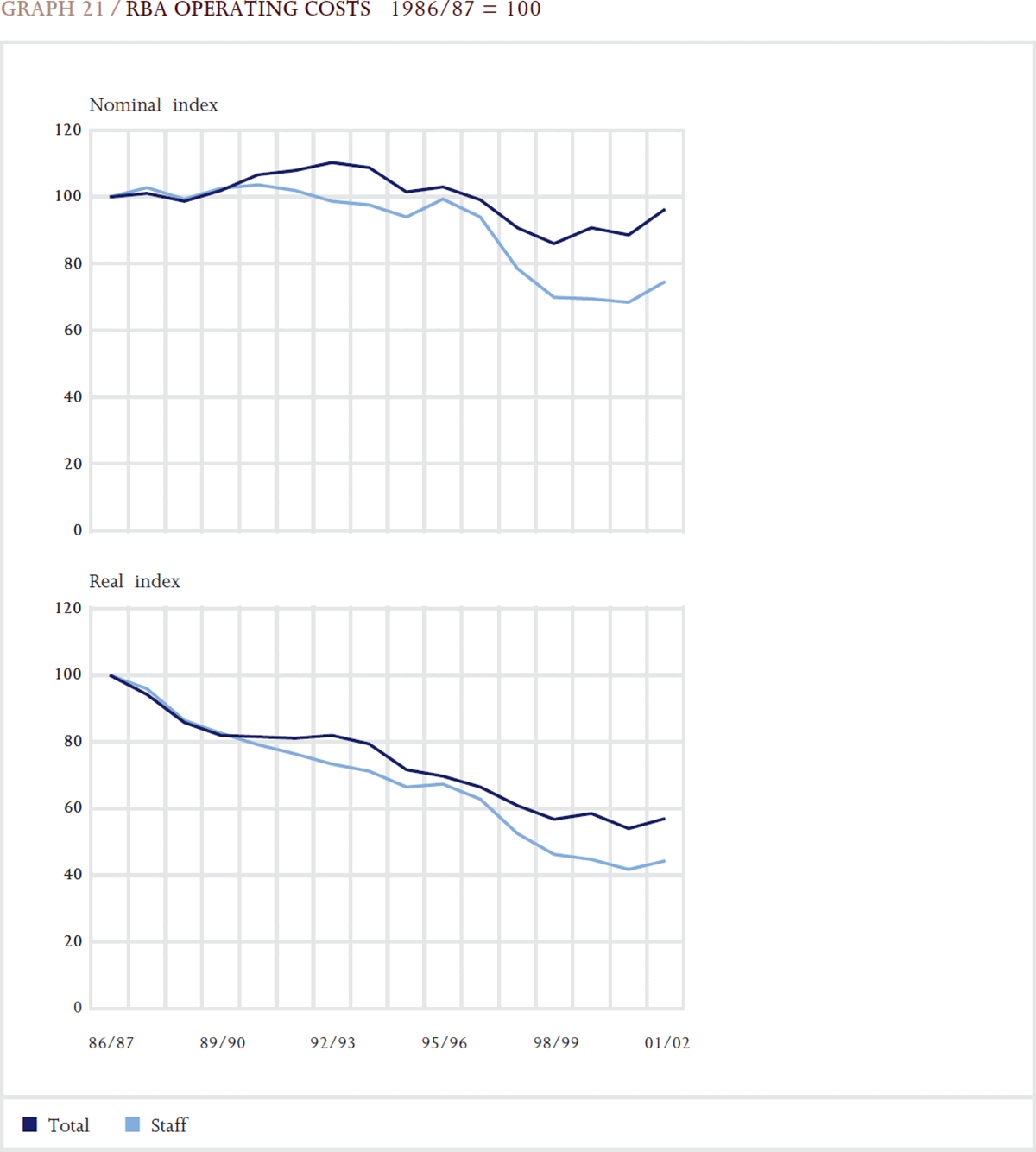Reserve Bank of Australia Annual Report – 2002 Management of the RBA
Staffing rose in 2001/02 as the RBA applied additional resources to support some new activities. This contrasts with the experience for most of the preceding two decades, when staff numbers fell progressively from around 3,200 in 1983 to 800 in 2001. This decline came largely from adopting better practices in the banking, registry and currency distribution areas, and partly because the application of information technology produced large efficiency gains. At the same time, the scope of these operations narrowed and costs were lowered elsewhere. Much of the contraction was concentrated in branches, most of which were judged to be in danger of becoming unviable and were therefore closed.
Over the past year or two, change in the RBA has been more incremental than has been typical for some time. The phasing-in of new arrangements for distributing currency was completed in June 2001, as the cash operation in Sydney closed, with a net loss of nine staff. At the same time, the new centralised facility for cash operations, the National Note Processing Centre (NNPC) at Craigieburn in Victoria, opened with about 20 staff, the only staff now involved in cash handling and distribution. These relatively small changes in numbers had been preceded by a period of large staff reductions in note issue: 655 had been employed in this area at its peak in 1983. In addition to the staff at the NNPC, 26 staff in Head Office are responsible for note issue policy and research.

The project to take direct control of the real-time gross settlement (RTGS) system in the Payments Settlements area moved to an advanced phase over the past year, with 11 new staff working directly on developing systems for this project.
In the administrative areas, the RBA has faced greater demands for regulatory and taxation compliance over recent years, with a net of two new staff appointed in 2001/02 to handle these responsibilities. More generally, there was also an increased intake of new graduates.
Overall, staff numbers increased to 823 in 2001/02, the first rise over a year since 1986.
The RBA continued in 2001/02 the process of modernising its workplace arrangements to attract and retain staff. One aspect of this process has involved designing compensation arrangements that better reflect contemporary market practice. This includes a move toward employing staff on individual employment contracts.
In recent years, external assistance has been sought to benchmark the responsibilities and remuneration of executive and managerial staff. A similar review of more junior staff was completed over the past year. Subsequently, this group was offered individual employment contracts, which involved, among other things, relevant staff forgoing the entitlement to housing assistance. Such assistance had earlier been withdrawn for new employees and for senior staff accepting the terms of contract employment. None of the most senior members of staff has a housing loan from the RBA.
Almost all of the eligible professional staff in policy areas – a group which is typically relatively young and not necessarily always well-placed to take advantage of the staff benefits that the RBA has traditionally made available – took up the latest offer. This suggests the approach has been successful in targeting a group with marketable skills. Individual employment contracts have also been extended to new graduate recruits. This provides a degree of flexibility in the compensation which can be offered to this group and assisted in meeting the increased demand for new graduates in 2002.
With these steps in 2001/02, around 53 per cent of staff – some 435 employees – are now on individual contracts, compared with little more than a dozen executives three years ago. The change to individual contracts has been entirely voluntary. Staff who declined the offer of contract employment have retained their existing conditions.
To date, the enterprise bargaining agreement has remained the basis of changes in conditions of employment for staff generally. Staff covered by this agreement received salary increases of 3.8 per cent in each of July 2001 and July 2002. Increases in salary in 2001/02 for staff on individual contracts were, on average, in line with increases for other staff.
Over the past year, the RBA extended its practices aimed at attracting and developing skilled staff. A more structured development program for graduate recruits was put in place. The cadetship scheme, through which the RBA attracts outstanding students at the start of their honours year at university, was adjusted so that job offers to cadets are now made at an earlier stage than in the past. The Post-graduate Study Award program was revised to make sure that the RBA continues to receive long-term benefits from it. In particular, reimbursement will be required from recipients of awards who leave the RBA prematurely. At end June 2002, seven staff were studying full-time under the Post-graduate Study Award program. A further 52 staff were undertaking part-time tertiary studies in Australia.
The RBA holds a licence to self-insure and manage its workers' compensation claims. The licence was renewed last year for three years by the Safety Rehabilitation and Compensation Commission. A recent review of insurance options indicated that costs still favour self-insurance.
Operating Costs
The increase in total operating costs of about 9 per cent in 2001/02 partly reflected the gearing up of the NNPC and associated currency processing and distribution arrangements. These arrangements have reduced the RBA's risks in the area of note issue by moving ownership of working stocks of currency to the banking system. They have also been associated with an increase in interest earnings and have eliminated over a number of years the costs of cash operations in the RBA as these have been closed. The overall effect on net earnings from these changes to cash arrangements has been favourable. The full-year effect in 2001/02 of establishing the regional economic offices the previous year also increased costs, as did the project to bring the RTGS system in-house. Some significant cost increases – such as those associated with making overseas pension payments on behalf of Centrelink – were offset by increases in revenue.

Despite the rise in total operating costs in 2001/02, these costs remain lower in nominal terms than at their peak in the mid 1990s; in real terms, they are still about 40 per cent below their peak.
More than half of operating costs are now incurred by the core policy functions of monetary policy and financial system surveillance. The remainder is spread evenly across note distribution, banking and registry operations, and the provision of settlement services. This pattern differs from a few years ago, when policy functions accounted for around 10 per cent less of operating costs, despite the transfer of responsibility for bank supervision to APRA since then. The new Regional Offices, in particular, have increased the share of spending by policy areas. This rising share of costs associated with policy responsibilities over time is, of course, in the context of the reduction from the peak in overall costs, which has been concentrated elsewhere in the RBA.
| 1993/ 94 |
1994/ 95 |
1995/ 96 |
1996/ 97 |
1997/ 98 |
1998/ 99 |
1999/ 2000 |
2000/ 01 |
2001/ 02 |
|
|---|---|---|---|---|---|---|---|---|---|
| Staff costs | 96.7 | 93.0 | 98.3 | 93.0 | 77.7 | 69.1 | 68.7 | 67.7 | 73.9 |
| Other costs | 53.0 | 46.4 | 43.2 | 43.4 | 47.2 | 49.1 | 56.1 | 54.1 | 58.4 |
| Underlying operating costs | 149.7 | 139.4 | 141.5 | 136.4 | 124.9 | 118.2 | 124.8 | 121.8 | 132.3 |
| Cost of redundancies | 9.8 | 18.0 | 1.3 | 7.5 | 20.7 | 18.4 | 9.3 | 2.6 | 3.4 |
| (a) Costs associated with the ongoing operation of the RBA, excluding NPA | |||||||||

The share of resources devoted to the provision of settlement services has increased, with the introduction of RTGS. On the other hand, costs associated with note processing and distribution account for a much smaller proportion of total costs than previously: in 1996/97, note issue accounted for 28 per cent of total operating costs, compared with about 15 per cent in 2001/02. The share of costs incurred by banking and registry has also fallen as these activities have been consolidated, most branch operations closed and the two remaining branches substantially reduced in size.
| Monetary policy | Financial system surveillance | Note distribution | Banking and registry | Settlement | |
|---|---|---|---|---|---|
| 1996/97 | 29 | 14 | 28 | 23 | 6 |
| 1997/98 | 30 | 14 | 23 | 23 | 10 |
| 1998/99 | 35 | 8 | 20 | 23 | 14 |
| 1999/2000 | 35 | 8 | 23 | 20 | 14 |
| 2000/01 | 41 | 9 | 17 | 18 | 15 |
| 2001/02 | 43 | 9 | 15 | 18 | 15 |
| (a) Excludes NPA | |||||
Facilities Management
The closure of the branch operations and lower staffing levels in Head Office have seen the RBA's accommodation needs diminish accordingly. This situation is being addressed by works to make surplus space available for leasing to external tenants in the Head Office in Sydney; by selling branch buildings when they no longer serve a business need; and by letting surplus space to tenants in the remaining branch buildings.
A major project of works for the Head Office building was approved by the Commonwealth Parliament in December 2000 following a recommendation by the Joint Parliamentary Standing Committee on Public Works. This project aims to make more efficient use of the space occupied by the RBA in Head Office, convert previously under-used ‘back-of-house’ space to office accommodation, and lease the resulting surplus space to suitable external tenants. The project is expected to make available for external lease about 5,500 square metres of space out of a total floor space in the building of around 30,000 square metres. The total works are estimated to cost $21.5 million.
The construction phase of the project began in September 2001. Construction is proceeding within budget and on time, with the program expected to be completed in the first quarter of 2003. A marketing campaign has commenced to lease the available space to tenants, with a lease for one floor already signed. The net revenue from leasing all of the available space is estimated at around $2.75 million in a full year.
Over the past year, the RBA sold its premises in Hobart for $4.5 million, and Perth for $18.75 million. It had previously sold its building in Darwin in 1997 and that in Brisbane in June 2001. Currently, discussions are proceeding with a potential buyer for its building in Adelaide. The RBA will continue to own its premises in Melbourne to support the activities of the NNPC, accommodate the Victorian Regional Office, and house external tenants. Its premises in Canberra support the RBA's transactional banking business and accommodate tenants.